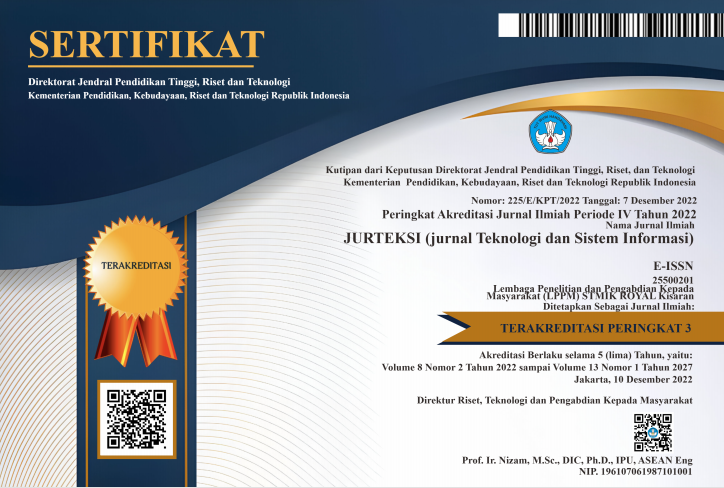COMPARISON FEATURE EXTRACTION USING ARTIFICIAL NEURAL NETWORK ALGORITHM ON SMOKER PREDICTION
Abstract
Abstract: The habit of smoking is dangerous because of the addictive substances that make cigarettes addictive. Its addictive nature poses a significant risk, affecting personality with stress, depression and nervous disorders. Body factors that indicate smoking include blood sugar levels, dental caries, and hemoglobin. To address this, research has been conducted with focused efforts to understand and address the risks associated with smoking and its impact on overall health. This research aims to choose the best method for predicting smokers by using feature selection techniques. The feature selection algorithms uses for that are Analysis of Variance (ANOVA), Recursive Feature Elimination (RFE), and Genetic Algorithm (GA) to select optimal attributes and uses the k-fold cross validation technique as the validation of the Artificial Neural Network algorithm. The data includes various parameters such as age, height, weight, vision, blood pressure, cholesterol, triglycerides, hemoglobin, AST, ALT, GTP, gender, dental caries and tartar. Hearing ability, urine protein content, and tartar were selected. The results showed that using the Analysis of Variance method showed higher accuracy (77.101%) compared to the Genetic Algorithm method (74.64%) and the Recursive Feature Elimination method (76.08%). Selection of relevant attributes increases the predictions and insights of the Artificial Neural Network model about the effects of smoking on health.
Keywords: artificial neural network; analysis of variance; genetic algorithm; recursive feature elimination; smoker prediction
Abstrak: Kebiasaan merokok berbahaya karena adanya zat adiktif yang membuat rokok menjadi ketagihan. Sifatnya yang membuat ketagihan menimbulkan risiko yang signifikan, mempengaruhi kepribadian dengan stres, depresi, dan gangguan saraf. Faktor tubuh yang mengindikasikan kebiasaan merokok antara lain kadar gula darah, karies gigi, dan hemoglobin. Untuk mengatasi hal ini, penelitian telah dilakukan dengan upaya terfokus untuk memahami dan mengatasi risiko yang terkait dengan merokok dan dampaknya terhadap kesehatan secara keseluruhan. Penelitian ini bertujuan untuk memilih metode terbaik dalam memprediksi perokok dengan menggunakan teknik seleksi fitur. Metode seleksi fitur yang digunakan adalah Analysis of Variance (ANOVA), Recursive Feature Elimination (RFE), dan Genetic Algorithm (GA) untuk memilih atribut yang optimal dan menggunakan teknik k-fold cross validation sebagai validasi algoritma Artificial Neural Network. Data tersebut mencakup berbagai parameter seperti umur, tinggi badan, berat badan, penglihatan, tekanan darah, kolesterol, trigliserida, hemoglobin, AST, ALT, GTP, jenis kelamin, karies gigi dan karang gigi. Kemampuan pendengaran, kandungan protein urin, dan karang gigi dipilih. Hasil penelitian menunjukkan bahwa penggunaan metode Analysis of Variance menunjukkan akurasi yang lebih tinggi (77,101%) dibandingkan dengan metode Genetic Algorithm (74,64%) dan metode Recursive Feature Elimination (76,08%). Pemilihan atribut yang relevan meningkatkan prediksi dan wawasan model Jaringan Syaraf Tiruan tentang dampak merokok terhadap kesehatan.
Kata kunci: artificial neural network; analysis of variance; genetic algorithm; prediksi perokok; recursive feature elimination
References
D. P. Sekeronej, A. F. Saija, and N. E. Kailola, “TINGKAT PENGETAHUAN DAN SIKAP TENTANG PERILAKU MEROKOK PADA REMAJA DI SMK NEGERI 3 AMBON TAHUN 2019,†PAMERI Pattimura Med. Rev., vol. 2, no. 1, 2020.
A. Bagaskoro and V. L. Amelia, “Hubungan Antara Konsumsi Rokok Dengan Status Nutrisi Pada Remaja,†J. Keperawatan Muhammadiyah, vol. 5, no. 2, 2020.
D. A. Supriyanto and T. Damayanti, “Correlation of Smoking Habit and Level of Nicotine Dependence in University Students,†Respir. Sci., vol. 3, no. 2, 2023.
D. K. J. Cameng and Arfin, “Analisis Penerapan Kebijakan Earmarking Tax Dari Dana Bagi Hasil Cukai Hasil Tembakau Terhadap Kesehatan Masyarakat,†Simposium Nasional Keuangan Negara. 2020.
M. Batta, “Machine Learning Algorithms - A Review,†Int. J. Sci. Res., 2020.
M. Zaffar, M. A. Hashmani, K. S. Savita, and S. A. Khan, “A review on feature selection methods for improving the performance of classification in educational data mining,†International Journal of Information Technology and Management, vol. 20, no. 1–2. 2021.
M. A. Arif, A. Jahan, M. I. Mau, and R. Tummarzia, “An Improved Prediction System of Students’ Performance Using Classification model and Feature Selection Algorithm,†Int. J. Adv. Soft Comput. its Appl., vol. 13, no. 1, 2021.
A. Triayudi and I. Fitri, “Comparison Of The Feature Selection Algorithm In Educational Data Mining,†Telkomnika (Telecommunication Comput. Electron. Control., vol. 19, no. 6, 2021.
N. Hasan and Y. Bao, “Comparing different feature selection algorithms for cardiovascular disease prediction,†Health Technol. (Berl)., vol. 11, no. 1, 2021.
M. Taghavi, A. Gharehghani, F. B. Nejad, and M. Mirsalim, “Developing a model to predict the start of combustion in HCCI engine using ANN-GA approach,†Energy Convers. Manag., vol. 195, 2019.
B. Thakur, N. Kumar, and G. Gupta, “Machine learning techniques with ANOVA for the prediction of breast cancer,†Int. J. Adv. Technol. Eng. Explor., vol. 9, no. 87, 2022.
C. Fan, M. Chen, X. Wang, J. Wang, and B. Huang, “A Review on Data Preprocessing Techniques Toward Efficient and Reliable Knowledge Discovery From Building Operational Data,†Frontiers in Energy Research, vol. 9. 2021.
D. P. M. Abellana and D. M. Lao, “A new univariate feature selection algorithm based on the best–worst multi-attribute decision-making method,†Decis. Anal. J., vol. 7, 2023.
A. Thakkar and R. Lohiya, “Attack classification using feature selection techniques: a comparative study,†J. Ambient Intell. Humaniz. Comput., vol. 12, no. 1, 2021.
S. Chen and C. Zhou, “Stock Prediction Based on Genetic Algorithm Feature Selection and Long Short-Term Memory Neural Network,†IEEE Access, vol. 9, 2021.
J. H. Seo and Y. H. Kim, “Machine-learning approach to optimize smote ratio in class imbalance dataset for intrusion detection,†Comput. Intell. Neurosci., vol. 2018, 2018.
M. Hussain, M. Dhimish, S. Titarenko, and P. Mather, “Artificial neural network based photovoltaic fault detection algorithm integrating two bi-directional input parameters,†Renew. Energy, vol. 155, 2020.













